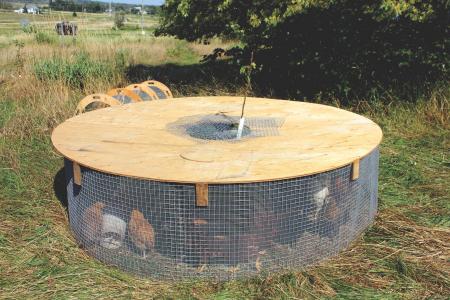 New Brunswick homesteader Kimberlee Bastien controls where her chickens free range with chicken tunnels and fertilization stations.
New Brunswick homesteader Kimberlee Bastien controls where her chickens free range with chicken tunnels and fertilization stations.
"There are hidden challenges with free-ranging," notes Bastien. "First, if given a choice, your chickens will spend at least some of their time ranging on your front porch, leaving a welcome mat of droppings for anyone who comes to visit. Your chickens could even decide to range on top of your car, in your garden or in the middle of the road."
Bastien's chicken tunnel, or chunnel, is designed to contain chickens on garden pathways. The round fertilization station is perfect for setting up around a young fruit tree.
To make a secure chunnel, Bastien starts with a 4-ft. wide roll of 16-gauge, galvanized wire mesh. While it could be any length, as it is attached to a wooden base, she suggests going with standard length boards.
"We chose to build ours 12 ft. long, so we used four 12-ft., 1 by 3-in. boards with 12 ft. of wire mesh," says Bastien.
The first step is to cut 1 1/2 in. off 2 of the 1 by 3-in. boards. Lay the boards parallel to each other and 4-ft. apart. Lay the mesh over the boards (overlapping each end by 3/4 in.) and staple the edges of the mesh to the boards.
Lay the uncut boards over the shorter boards, again overlapping by 3/4-in. at each end. Attach the boards together, sandwiching the wire mesh.
Oblong pieces cut out of plywood and measuring 22 in. wide at the base and 19 in. tall serve as ends to the chunnel and also reinforce it.
Drape the wire mesh over the plywood ends with the shorter boards on the inside and secure the mesh to the ends with screws and washers. Start at the peak and work down on either side to the 1 by 3-in. boards. Bastien recommends reinforcing the chunnel with three, 2-ft., 1 by 3-in. crosspieces if the chunnel will be moved.
Bastien's fertilization stations fit around trees to clean up insects, remove grass, and fertilize throughout the growing season.
The donut-shaped lid with its center hole fits around trees while resting on a 24-in. high, wire mesh perimeter.
"The design is simple and uses materials that are long lasting, recyclable and biodegradable," says Bastien.
To make the circular station, lay two 4 by 8-ft. sheets of plywood side by side to create a square. Find the center and use a 4-ft. piece of string to scribe an 8-ft. diameter circle on the boards. Scribe an 18-in. circle at the center of the two panels, as well as 18-in. circles in each of the panels. The center circle allows it to be placed around trees up to 18 in. diameter.
The second and third circles provide access for supplemental feed and water. These circles, when supported by lips on the underside of the panel, can be used as access lids.
Handles attached to the lids, or holes in them, make them easy to remove, points out Bastien. However, she notes they can also make them easy for raccoons to remove.
Bastien attaches 1 3/4-in. lips to the straight edges of one of the panels, using two, 35-in., 1 by 4-in. boards. When this panel is laid (lip side down) over the wire pen, the second panel is screwed to the lips to create the roof.
To secure the roof panel to the wire mesh, Bastian screws and glues eight, 4-in. long, 1 by 3-in. boards every 3-ft. along the inside perimeter of the bottom side of the roof panels. A second set of 4 by 1 by 3-in. boards is screwed and glued at a distance of 3/8-in. inside the first set.
Assembly is a matter of placing the roof halves around a tree, unrolling the wire mesh to match the diameter of the roof and then setting the roof panels in place and securing them.
When the roof is laid in place, the slots sandwich the mesh. They are further secured to the mesh by drilling holes through the slots for a locking screw.
Bastian suggests creating a small door in the wire mesh for use when introducing chickens.
"Just like the chunnel, the fertilization station isn't permanent," says Bastian. "It is designed to be moved from tree to tree every few days."
Bastien shares her experiences with free-range chickens and the designs for her solutions in detail in her book "52 Homestead Skills." The book is available for $24.95 from Grit.
Contact: FARM SHOW Followup, Ogden Publications, 1503 SW 42nd St., Topeka, Kan. 66609 (ph 866 803-7096; www.grit.com/store/product/52-homestead-skills).
1-800-834-9665
Moveable Coops Control Chicken Free-Ranging
FARM SHOW Magazine » Moveable Coops Control Chicken Free-Ranging
Moveable Coops Control Chicken Free-Ranging
